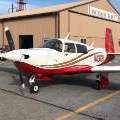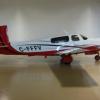Leaderboard
Popular Content
Showing content with the highest reputation on 04/01/2013 in all areas
-
Hey guys, for those of you who've been following my parrot stuff, just wanted to let you know I've had enough and shot polly dead:2 points
-
Although what Dan's says is very accurate, it may not be answering your question. At max cruise power settings we can and usually do operate much further ROP (150F or more) than we can operate LOP simply because power drops off very rapidly lean of peak compared to ROP. But to get to the heart of your question, a lean air-fuel mixture burns slower than a richer mixture, resulting in the higher EGTs/TIT that you are observing; combustion is continuing even as the exhaust valve opens resulting in higher temps downstream. Consequently, our ability to run higher LOP power settings in our turbo's is limited foremost by TIT. Or perhaps more realistically by our tolerance to operate closer to redline TIT. You undoubtedly also noted that your factory massive TIT probe reads between 50-100F cooler than the faster responding hastaloy-X-tip JPI probe which are in theory also more accurate than the factory massive probe. So although the factory probe is still the "legal" 1650F TIT limiting probe, I personally operate by the more limiting JPI probe reading 100F hotter and I also observe a more conservative limit of 1580F as my personal max TIT. Within that limit, I find I can operate LOP only up to 71.7% power (@11 GPH) to stay within that. However, I find I am only losing a couple knots TAS (from GPS testing) so I am not dissatisfied by that. Also I have the same LOP temp range you specified (~40 to -80 LOP). I know of no real data though that would confirm lower or more conservative TIT management will actually improve turbo longevity. But if you’ve ever seen your turbo operating, you'll see it’s glowing a bright red above 1400F. I personally had not noticed or observed lower CDT's and will remember to compare in a future flight. However, assuming RPM and altitude are unchanged, we know the same mass of air per unit time at the same ambient temperature are being compressed by the compressor, so Boyles law suggest the temperature should be higher rather than lower. However, I wouldn't view a cooler CDTs as indicative of a cooler running turbo temperature. The turbo temperature that limiting to the turbo is TIT, from the hot exhaust gases going through it; which is running hotter LOP than ROP.1 point
-
To update our progress, we have sped the plane up from 177 MPH to 193 MPH with improved flying technique and some airplane optimization. Flying technique: The M20J is fast because it has low drag. It does not have the power the Bonanza's and other similar planes have and this really shows up in climb. So if you are going to go fast, you need to be smart about it and minimize your time spent climbing. Now, winds aloft play a big part in the air races and you need to optimize your climb profile to take advantage of it. The best climb strategy to get higher to net more tailwind is maximum available power, full throttle, 2700 RPM, and about 1400 EGT with a 360 CHT. Second, the IAS is about 185-190 MPH during the event, and the best forward speed for climbing is about 5-10 MPH less than maximum. You just let it drift up. Now if you round a pylon and find a headwind, you descend 500 FPM or less, use the smaller gain in airspeed over longer period to minimize drag from flying at high IAS. Turns: anything over a 90 degree turn at the mark is done at 60 degrees of bank, but not a level turn, you lose too much speed. Allow the plane to drift down ~500 FPM in the turn which results in a net loss of around 200 feet for a 90 degree turn, about twice that for a 180. You basically smoothly bank the plane over a 3-4 second period to 60 but do not load the wing to 2 G's as you would in a level turn. Perhaps 1.3 G. Allow the nose to fall 3-5 degrees below the horizon to maintain race airspeed, and then climb 100 FPM for 3 minutes with a very small speed loss for the next leg. Smooth control inputs with minimal deflection is key. For a 45 degree turn, a simple method is use bank angle to equal degrees of turn. Your flight path over the ground should look like a parabola with the pylon at the apex. If you fly right at the pylon and then turn at the last second, your exit will be very wide, remember you are covering 3 miles per minute, or 300 feet per second. You have to approach the pylon with 1500'-2000' of lateral room to make the turn, you turn radius at a 60 degree level bank, 180 knots is 1600 feet and takes .8 NM of flying distance, but since you are not in a 2 G turn, its perhaps double that. You approach the turn and when you have the apex, go for 60 degrees of bank. Your first few you will be really wide, you have to lead the turn to make the apex. RH turns really need a copilot in these races or you will blow it and add an extra mile to your flight. Flying pilot: Fly smoothly and accurately, nothing else. Two hands on the yoke help along with your wrist on your knee. Second pilot: invaluable for monitoring the engine state, the flying pilot's course and altitude, watching for traffic, birds, radio calls, guiding the flying pilot into lateral position to make the next turn, calling the RH turns, monitoring the rollout heading and winds aloft / wind trade to maximize tailwinds and minimize headwinds. Engine: Horsepower to the crank is everything here, and make sure you are getting all you can. Full throttle and 2700 RPM, lean to 360-380 CHT. This is worth a couple and perhaps 5 MPH because you are making more power at the crank with a leaner mixture than full rich. Best power is 80 ROP but you cannot achieve that without melting something or running into heavy detonation. Don't even try it. However, you can lean in 1/2 GPH increments and let it stabilize for 2 minutes, then lean more until you get a 380 CHT then stop there. Watch it like a hawk. The second pilot should be doing this as the flying pilot is, and should be, consumed with flying smoothly. Ditch the Brackett air filter, which costs you 3 HP and 1/2" MP at full throttle, and get a Donaldson or Challenger air filter. Ensure the throttle is opening to the stop. Make sure your engine is turning the full 2700 RPM with an optical or digital tach. Fly it for 5 minutes at WOT with the prop full forward to verify it. Mechanical tachometers read high often, and what you think is 2700 RPM is only 2625, and that costs you HP and speed. Ensure that baffle in the muffler is in good condition and not collapsing on you, that hurts exhaust flow. Supposedly they are not airworthy without the flame cone baffle in there but I know they are not slower with it missing. Make sure you have the full 25 degrees timing, or the 20 degrees as called for on the data plate, or some cheat and run 23 degrees on a 20 degree engine. That Lycoming service bulletin has been beat to death on here, but the only difference in a 20 and 25 degree IO-360 engine is the impulse coupler on the left magneto. Airframe: remove unnecessary antennas, and if you have draggy antennas, consider replacing them for modern antennas. We still had the "7" antennas which are pretty optimal (until one went bad, we replaced it with a Comant CI-196). You can reduce drag from transponder and DME "ball on a stick" antennas with Comant CI-105 blade antennas. Any kind of a rod antenna or whip antenna is a lot of drag. We replaced the ELT antenna with a Pointer model which was shorter, and raked. We also removed the CI-122 bent whip LORAN antenna and a huge King ADF antenna, both were replaced with a flush patch. Make sure your ball is in the center in cruise, the gear doors close tightly, cowling is aligned and not riding up as J cowls tend to do, and the engine mounts are not sagging. Check the spinner is centered in the cowling and there is no right thrust in the mount. You can shim the engine as Don Maxwell's article says to do. When its right on a M20J, the engine has 1/2" right offset at the spinner point and it has zero down thrust. The crankcase top is perfectly level with the airplane jacked to level, and the spinner gap between the cowl and the backplate is parallel. The flaps and ailerons are all at 0 to -2 degrees and in line with each other. Ensure the cabin and baggage doors close flush and the seals are not leaking. Check the elevators, ours had a 2 degree split. Rig the cowl flaps to close tightly to the bottom of the cowling. Re-rig the tailpipe to tuck up into the tunnel on the bottom of the fuselage. Ensure the prop is clean with no dings on it, and the paint is in good condition on the leading edge. Wash and wax the entire plane with careful attention to the leading edge and the first two-three feet. This wing is laminar flow and any contamination, dead bugs, even chipped paint, will trip the boundary layer and increase drag. There is a reason you lose 2-3 MPH IAS in rain, because the laminar flow is tripped. Minimize that. Ensure the roof scoop vent is closed tightly. and close the outside air vents. Air in the cabin is air out of the cabin side vents, and that is drag. You can tape the baggage door, side vents, scoop, and cowling but we elected not to because it strips off our old tired paint. Get the CG aft. Adding weight to the baggage area hasn't proved to pay off, but the flying pilot sitting as far aft as possible and the second pilot with the seat fully aft and reclined, sitting as far up on the seatback as possible does. All of these little things add up to 16 MPH in this case, and there may be a couple more left in the old bird. We will find out.1 point
-
A 10-32 truss head machine screw with a locknut will work fine too. (Locknut on the inside of course.) Lee1 point
-
Jamie just one more note on this subject. Keep in mind that folks like PIC have very advanced instructors that come to you. It is by no means cheap but the quality of instruction is generally over the top. Most local flight schools or instructors are kids that are there trying to build time and barely know more than you. Looking back when I started my own flight school and started instructing, I had little over 200 hours. And after flying over 700 hours during my first year of instruction It's amazing that I'm still alive! Well not really but one thing I did before I started instructing was I took a 20 hour aerobatic course in a Super Decathlon. I highly recommend a course like that for everybody. It boosted my confidence exponentially and I knew no matter what position the plane was in, I could get it back to where it should be. The only maneuver I would be nervous about getting myself into would be an inverted spin and it's one that I have never done. Yet! Come on Seth, we need to buy that aerobatic plane!! I also remember when I was doing my instrument training we were taxiing out in our little 152 about to fly some actual IMC for the first time and I was really nervous. I turned to my instructor and said please keep a close eye on me as I am a bit nervous and he looked at me and said "me too" "how often do you think I do this?" Well that surely didn't instill a lot of confidence in the flight we were about to take but it all worked out.1 point
-
Excellent advice. I like choosing which tank to use as the first item in my preflight. Had a friend who was badly hurt, along with his passengers, when he changed tanks to the fullest tank, or so he thought, before take-off. I visited him in the hospital, and he recalled reaching down to turn the selector, but didn't "jiggle" it for digital feedback. Better to learn from other's mistakes. This forum is really useful in this (perverse) way.1 point
-
From Lycoming's article you quoted: "Lycoming recommends cruise operation at peak EGT or TIT, which is the point where the best economy range starts." From Lycoming's operation recommendations for the TIO-540-AE2A: "Lycoming recommends that a cruise setting of 65% power be used..." They clearly state CRUISE operation and peak EGT OR TIT. To me this indicates na OR turbocharged? Which part of this isn't clear?! Anyone is free to pick and choose fragments out of context.1 point
-
1 point






